Laser Removing Risks on – Tattoo
Basically, I think everything is clear with eyebrows. It’s hard to do something wrong. But with the removal of tattoos, the situation is somewhat different. The tattoo is one of the most dangerous areas in terms of damage and marks on the skin.
There may be scars
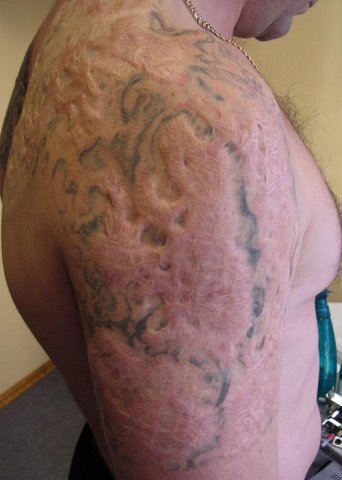
Or even worse

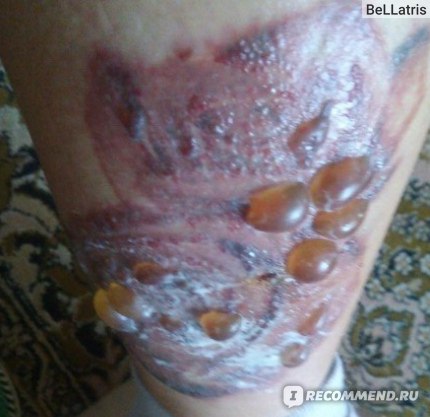
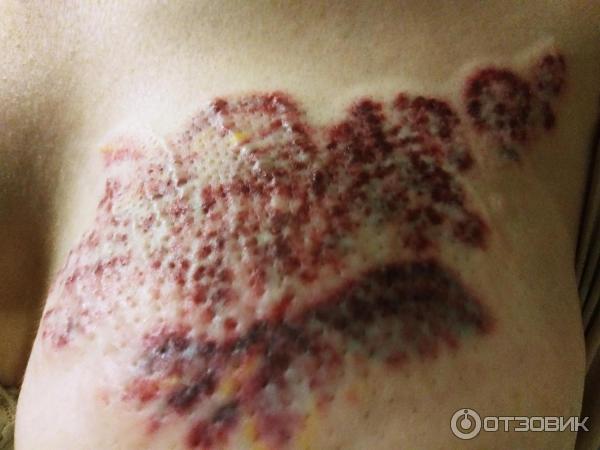
I do not want to scare anyone, but only to show the consequences of the improper tattoo removal with a laser. In these photos, we see the wrong laser removal and only the master is to blame.
To avoid such situations, you need to work very carefully with a tattoo.
We discussed with you that it is very dangerous to work with tattoos in the first sessions. The first three sessions are dangerous.
In these sessions, you need to work at the minimum laser power settings. The spot diameter is 6-8 mm so that the skin of the client does not rise, as in this photo.

It is necessary to achieve moderate clarification. A small skin reaction is enough because large granules of the pigment is enough for destruction. Do not give in to the provocations of the client who asks to remove the tattoo as soon as possible. It will cost you more.
How to protect yourself?
- Saturated black color
- Fresh tattoos for up to 6 months.
- Cover-up – when one tattoo is covered by another (here you need to ask the client if the tattoo was covered with another tattoo because if there was a cover-up, the pigment concentration in the tissues will be higher)
- Contour tattoos – when the contour of the tattoo is very tight.
You should work very carefully with these types of tattoos! When working with saturated black tattoos and tattoos above from the list, you must use three types of cooling.
Pre-cooling is not required if working with eyebrows, and for a tattoo it is necessary. We take a cooling pack and apply it to the tattoo site, which we will remove before removing the tattoo site to apply for 20-30 seconds. Thereby you protect yourself from overheating of the skin.
- As soon as you have treated the skin area with a laser, immediately apply a cooling bag. It is necessary to take the excess heat from the tissues.
- If possible, use air cooling during removal. The simplest thing is to take a hairdryer, turn on the mode without heating and cooling the removal point during the procedure. This airflow will very well solve the problem with possible complications after removal. Perhaps this is strange, but the airflow during laser operation removes the excess heat released during removal and reduces the likelihood of skin heat shock. Painful feelings during the procedure will decrease by several times, and in the next session the client will surely say –” I will only remove the tattoo with a hairdryer”)) This method is not used by many people, but now when you know about it, you just have to use it when removing.
Now let’s look at how to remove colored tattoos.
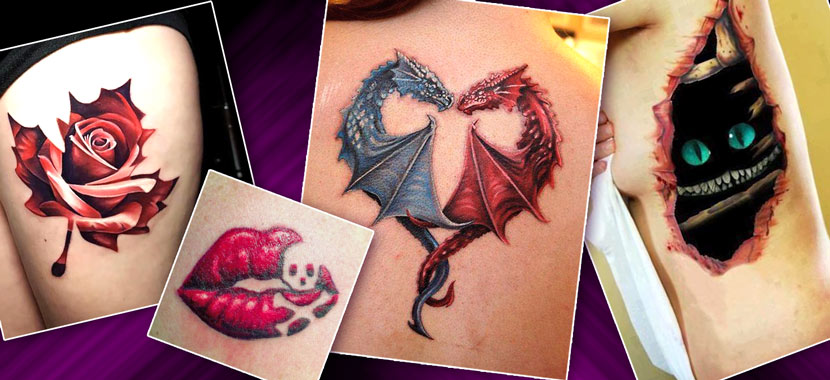
Color tattoos are removed in the following sequence – first, the nozzle 1064 Nm remove all black, then change the nozzle to 532 Nm and locally carefully process the red zone. If there is a green color, then working on it two first nozzles 1064 Nm, then 532 nm. Do not forget about the diameter of the spot 6-8mm and try not to touch the already treated areas of black pigment with the 532 nozzle. Note that the complete tattoo removal can take 10-15 with the pause at 2-2.5 months and the farther it is, the more can be the pause. That is, for 5-6 sessions, the pause can be 3-4 months, and the final sessions will already be once every 6 months because the visual changes will go very slowly. World statistics show that only 3-5% of all the clients who applied to you will pass the removal course. Therefore, your task as a businessman and businesswoman to keep the client as long as possible. So, do not worry if your customers will leave you after 4-5 sessions. Just do whatever you can to get them to come to you.
Yellow and light orange colors may remain and not be removed completely.
Immediately after removing the tattoo, no bandages, ointments and other things should be applied, cooling is enough. With proper removal work with a tattoo, there should be no wounds.
If you still overheated the skin and the client reports the appearance of burns, soothe the client and recommend to treat the area with antiseptic and apply protective bandages. You can use Bepanthen ointment, as well as healing bandages for wounds by Hartmann.
If scars have occurred during removal, they should also be looked after in order to at least get minimal marks.
Classification of Scars
- Atrophic Scar – inadequate replacement of deleted collagen fibers. (Pitted Scar, Acne Scar)
- Hypertrophic Scar – Overzealous healing response
- Normotrophic Scar – The vast majority form as a result of an adequate reaction of the body to an injury.
- Keloids – growth beyond the original wound
Normotrophic scars maturing give a white color, they are flush with the skin, they do not deform the skin, do not affect the mobility of the surrounding tissues, usually differ only in the texture of the skin, in the absence of a skin pattern on the scar. Normotrophic scar is an ideal outcome of almost any damage. It doesn’t make any sense to do anything with it and modify it.
It looks like this

The atrophic scar is a fossa
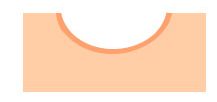
In most cases, the tissue is lost. Typically, these scars are formed as a result of acne, herpes, etc. Characterized by a lack of tissue in this area. They need correction.

A hypertrophic scar is an increase in tissue in the scar area

Hypertrophic scars – is more or less normal conditions. They occur when the scar has “some kind of inconvenience” during healing. Irritation outside, mobility, some kind of irritation of the skin in the healing process, which causes the excessive formation of collagen. They mature longer than normotrophic and atrophic ones, maybe reddish, purple. It is hypertrophic scars that are often confused with keloids.

Keloid scars are formed when the scar is much more than the injury. Moreover, keloid scars continue to capture nearby tissues in the structure of their scar. A keloid scar has a characteristic structure, the surface of the scar looks inflated and stretched. Usually, it is bright red, causing itching, tingling. The most annoying thing is that it is constantly at the stage of active growth and can grow for a very long time. Keloid scars are referred to as pseudotumor diseases.
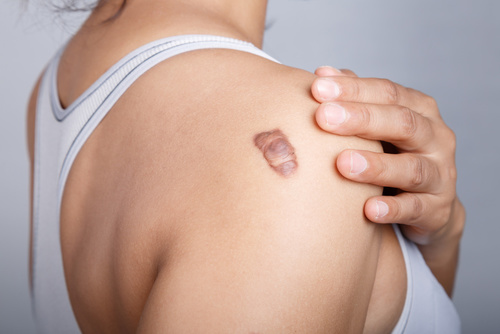
Other types of scars are considered to be normal. Hypertrophic and atrophic types need correction. They can be corrected by injection of hyaluronic acid, Rf lifting, Fractional lasers, but it is impossible to get rid of the scar to get even skin. The maximum most that can be done with the scar are to bring it to a more harmonious appearance with respect to the surrounding tissues.
That was a brief classification of scars.
Now, how to take care of scars?
The first rule: care for the scar should begin immediately after the crust has fallen off. If you start to take care of immediately, you will end up with the best possible outcome.
- Optimum conditions for the scar: a minimum of irritating factors affecting the scar. In response to irritating factors, the scar surface may form dense and coarse. There are such silicone products specifically for scars, for example, Dermatix Gel. The gel is applied to the surface of the scar and protects against external irritants.
- Use special care products such as Mederma, Contractubex. It would be good to combine these two drugs with ultrasonic treatment. With the help of ultrasound, deeper penetration of these preparations into the scar tissue occurs, and tissue micro-massage also takes place. As a result, the scar matures better, smoother and more even.
But all these methods still do not relieve you completely from the scar. It will just be more aesthetic.
- Let’s summarize this lesson:
- In the first session the minimum power
- Start increasing the power with 4-5 sessions
- We work with a spot diameter of 6-8 mm
- We achieve moderate whitening.
- Cool the tattoo before the procedure with a cooling package, during the procedure with a hairdryer or something else and after the procedure with a cooling package.
All these stages will save you from most problems. And now we proceed to the next lesson – the removal of permanent lip makeup.
